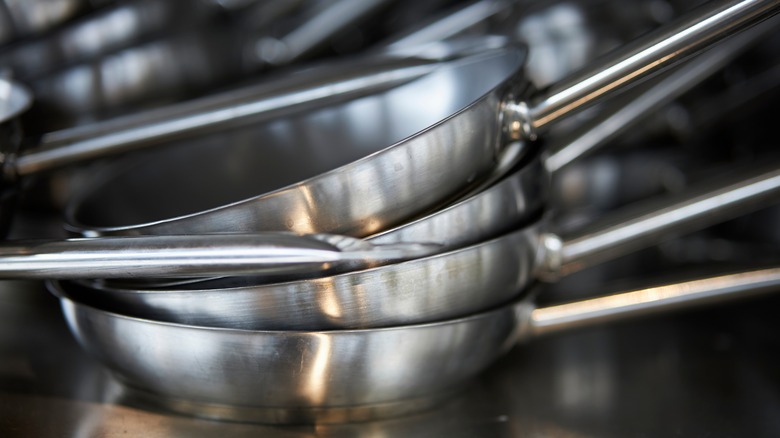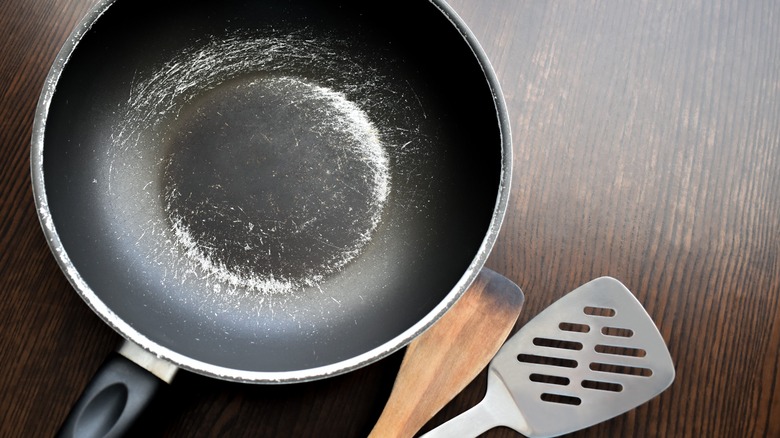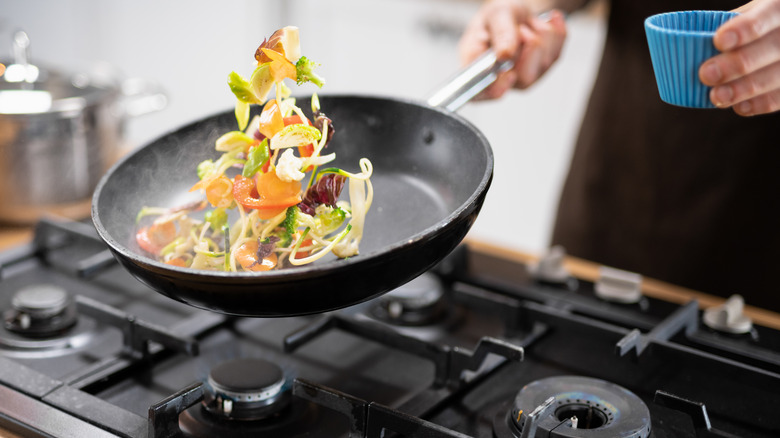Why You Shouldn't Stack Pans When You Store Them
When organizing cookware in your kitchen, you may give large slow cookers and blenders their own space, but pots and pans often fall at the bottom of the ladder, being messily stacked upon one another and squeezed into whatever space can be spared. As one of the most-used tools in your kitchen, your pans deserve a better storage technique that helps them last longer, especially if you use non-stick pans.
When you stack non-stick pans, the bottom of one pan can scratch the surface of the one that sits below. This can damage the slick coating that gives your pan its non-stick powers, which means that your food will be more prone to sticking and burning, and your pan may need more grease than usual to do its job.
There are plenty of creative ways to store pans without stacking them and risking the damage. You can divide your cabinets into smaller shelves, used tiered organization stands, or hang the pans on pegboards. If you have a small kitchen, you can even store pans in the oven when it's not in use. If you absolutely must stack them, consider layering the pans with towels and pot holders in-between to protect their surfaces.
Scratched non-stick pans can be hazardous
Damaging a pan's non-stick cooking surface will not only make cooking more difficult, but it may even have negative implications for your health. The reason why non-stick pans work the way they do is because of a coating made from per- and polyfluoroalkyl substances, one of the most famous being Teflon. Known as PFAS, and more colloquially as "forever chemicals," these substances have long had a questionable reputation regarding health and safety.
A 2022 study published in Science of The Total Environment found that when there is any abrasion on the surface of Teflon cookware, the chemical can break into minuscule microplastics and nanoplastics. These particles can easily leach into the food that you're cooking in the pan and subsequently be ingested.
Once consumed, these chemicals can have several adverse health effects, including a compromised immune system and a heightened risk of certain types of cancer, says the United States Environmental Protection Agency. That said, newer non-stick pans manufactured after 2013 are made using an improved version of Teflon that lacks some of its more harmful chemicals. Scratches on these aren't as much a cause for worry as they are on older pans, but it's always better to prevent the damage anyway. If you can help it, it's still best to avoid stacking your pots and pans.
Other mistakes that can compromise your pans
Stacking pans is one way to damage their non-stick coating, but there are other things that could ruin your non-stick pans, too. For example, PFAS can cause toxic fumes to release from a non-stick pan when it is dry-heated, i.e heated without any oil, butter, or food in it. High heat is another danger to beware of. Teflon starts to disintegrate when it reaches a temperature of 500 degrees Fahrenheit or higher, and can leave dangerous gases in its wake. Long-term exposure to these gases can lead to what's known as Teflon flu, whose symptoms include fever and body aches (via Healthline).
Lastly, it's important to minimize the cookware's exposure to anything that can cause chafing. Beyond stacking the pans, metal and steel tools don't go well with these pieces of cookware, so it's best not to use utensils or abrasive cleaning products made from such materials. Even the high temperatures of a dishwasher can damage the non-stick surface, so hand-washing the pans is always the better option. Non-stick pans are a boon for effortless cooking, but when not taken care of, even something as little as storing or cleaning them improperly can have dangerous effects.



